Objective
To perform rolling process on an lead bar in order to observe the change in both the cross-sectional area and the general shape.
Flat rolling or Rolling is defined as the reduction of the cross-sectional area of the metal stock, or the general shaping of the metal products, through the use of the rotating rolls [1]. It allows a high degree of closed-loop automation and very high speeds, and is thus capable of providing high-quality, close tolerance starting material for various secondary sheet metal working processes at a low cost [1].
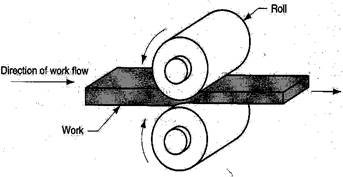
Figure 1. Rolling Process [2]
The rolls rotate as illustrated in Figure 1. to pull and simultaneously squeeze the work between them. The basic process shown in Figure 1 is flat rolling, used to reduce the thickness of a rectangular cross section.
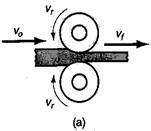
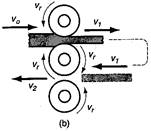
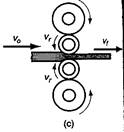
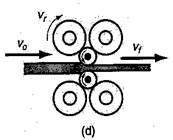

Figure 2. Various configurations of rolling mills: (a) two high, (b) three high, (c) four high, (d) cluster mill, and (e) tandem rolling mill [2].
Various rolling mill configurations are available to deal with the variety of applications and technical problems in the rolling process. The basic rolling mill consists of two opposite rotating rolls and is referred to as a two-high rolling mill (Figure 2a). In the three-high configuration Figure 2(b), there are three rolls in a vertical column, and the direction of rotation of each roll remains unchanged. To achieve a series of reductions, the work can be a passed through from either side by raising or lowering the strip after each pass. The equipment in a three-high rolling mill becomes more complicated, because an elevator mechanism is needed to raise and lower the work [2].
Roll-work contact length is reduced with a lower roll radius, and this lads to lower forces, torque, and power. The four-high rolling mill uses two smaller diameter rolls to contact the work and two backing rolls behind them. Another roll configuration that allows smaller working rolls against the work is the cluster rolling mill.
To achieve higher throughput rates in standard products, a tandem rolling mill is often used. This configuration consists of a series of rolling stands. With each rolling step, work velocity increases, and the problem of synchronizing the roll speeds at each stand is significant [2].
The primary objectives of the flat rolling process are to reduce the cross-section of the incoming material while improving its properties and to obtain the desired section at the exit from the rolls. The process can be carried out hot, warm, or cold, depending on the application and the material involved. The rolled products are flat plates and sheets. Rolling of blooms, slabs, billets, and plates is usually done at temperatures above the recrystallization temperature (hot rolling). Sheet and strip often are rolled cold in order to maintain close thickness tolerances.
Basically flat rolling consists of passing metal between two rolls that revolve in opposite directions, the space between the rolls being somewhat less than the thickness of the entering metal. Because the rolls rotate with a surface velocity exceeding the speed of the incoming metal, friction along the contact interface acts to propel the metal forward. The metal is squeezed and elongated and usually changed in cross section. The amount of deformation that can be achieved in a single pass between a given pair of rolls depend on the friction conditions along the interface. If too much is demanded, the rolls will simply skid over stationery metal. Too little deformation per pass results in excessive cost.
Rolling involves high complexity of metal flow during the process. From this point of view, rolling can be divided into the following categories [3]:
The distinctive mark of hot rolling is not a crystallized structure, but the simultaneous occurrence of dislocation propagation and softening processes, with or without recrystallization during rolling. The dominant mechanism depends on temperature and grain size. In general, the recrystallized structure becomes finer with lower deformation temperature and faster cooling rates and material of superior properties are obtained by controlling the finishing temperature [1].
Hot rolling offers several advantages [1]:
The upper limit for hot rolling is determined by the temperature at which either melting or excessive oxidation occurs. Generally, the maximum working temperature is limited to 50°C below the melting temperature. This is to allow the possibility of segregated regions of lower melting material [4].
Cold rolling, in the everyday sense, means rolling at room temperature, although the work of deformation can raise temperatures to 100-200°C. Cold rolling usually follows hot rolling. A material subjected to cold rolling strain hardness considerably. Dislocation density increases, and when a tension test is performed on this strain-hardened material, a higher stress will be needed to initiate and maintain plastic deformation; thus, the yield stress increases. However, the ductility of the material – as expressed by total elongation and reduction of area – drops because of the higher initial dislocation density. Similarly, strength coefficient rises and strain-hardening exponent drops. Crystals (grains) become elongated in the direction of major deformation [1].
Cold rolling has several advantages [1]:
The main problem during rolling process is the calibration of rollers. This calibration faults may occur in case of used bearings and may affect the thickness of parts. A simple classification is as here below:
Change of rollers speed
Material temperature
Roller temperature
Inlet thickness
Material properties
Eccentric and conical rollers
Used bearings
Parallel position of rollers
Surface geometry of rollers
[1] Shey, John A., Introduction to Manufacturing Processes, 2nd Edition, McGraw-Hill Book Company, New York, 1987.
[2] Groover M.P., Fundamentals of Modern Manufacturing, John-Wiley and Sons, New York, 1999.
[3] Rolling Process, http://www.cemr.wvu.edu.
[4] Dieter, G.E., Mechanical Metallurgy, SI Metric Edition, McGraw-Hill Book Company, London, 1988.
Source: http://www.mslab.boun.edu.tr/rolling.doc
Web site to visit: http://www.mslab.boun.edu.tr/
Author of the text: indicated on the source document of the above text
If you are the author of the text above and you not agree to share your knowledge for teaching, research, scholarship (for fair use as indicated in the United States copyrigh low) please send us an e-mail and we will remove your text quickly. Fair use is a limitation and exception to the exclusive right granted by copyright law to the author of a creative work. In United States copyright law, fair use is a doctrine that permits limited use of copyrighted material without acquiring permission from the rights holders. Examples of fair use include commentary, search engines, criticism, news reporting, research, teaching, library archiving and scholarship. It provides for the legal, unlicensed citation or incorporation of copyrighted material in another author's work under a four-factor balancing test. (source: http://en.wikipedia.org/wiki/Fair_use)
The information of medicine and health contained in the site are of a general nature and purpose which is purely informative and for this reason may not replace in any case, the council of a doctor or a qualified entity legally to the profession.
The texts are the property of their respective authors and we thank them for giving us the opportunity to share for free to students, teachers and users of the Web their texts will used only for illustrative educational and scientific purposes only.
All the information in our site are given for nonprofit educational purposes